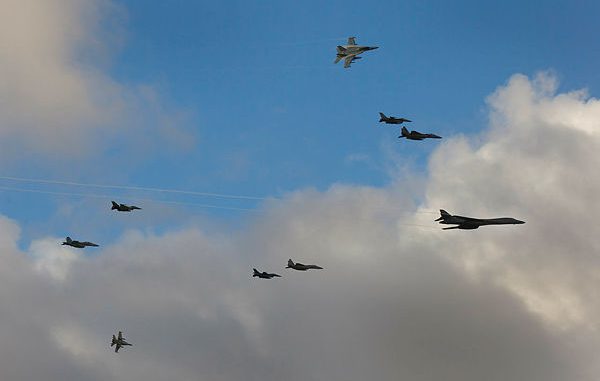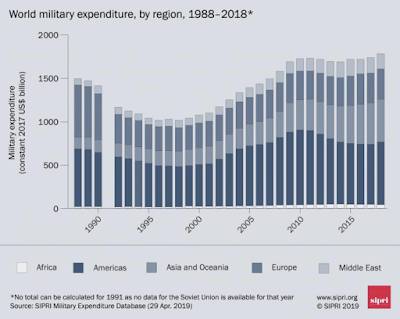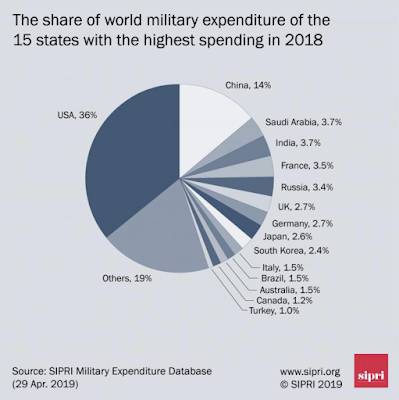
With Mike Pompeo and John Bolton rattling the sabre at just about every turn, the recent report on global military expenditures for 2018 by the Stockholm International Peace Research Institute (SIPRI) is particularly pertinent. Here are some of the highlights that will help you to better understand how much governments around the world spend on equipment that is solely designed to killing maim as many human beings as possible.
In 2018, total global military expenditures rose by 2.6 percent on a year-over-year basis, reaching a record $1.822 trillion in nominal terms. This is the highest level since 1988, the first year for which consistent global military spending data is available. Given that the Cold War ended in 1991, it is interesting to note that global military spending is now 76 percent higher than the post-Cold War low in 1998.
Here is a graph showing how global military spending has grown since 1988:
Total global military spending in 2018 represented 2.1 percent of global gross domestic product or $239 per person.
Here is a pie chart showing the 15 top global military spenders:
In 2018, military spending by the United States and China accounted for half of the world's total military spending.
Let's look at military spending in 2018 by three of the big players in our new multipolar world:
1.) United States – For the first time since 2010, U.S. military spending grew by 4.6 percent on a year-over-year basis, reaching $649.798 billion. This is almost as much as was spent by the next eight largest-spending nations combined. Over the past decade, in constant 2017 U.S. dollars, U.S. military spending has actually dropped from a peak of $784.835 billion in 2010. As a share of GDP, over the past decade, U.S. military spending has dropped from a peak of 4.7 percent in 2010 to its current level of 3.2 percent. During the Cold War era, U.S. military spending comprised 5.7 percent of GDP in 1988 and 5.5 percent of GDP in 1989. After the Cold War ended, U.S. military spending actually dropped to a low of 2.9 percent of GDP in the years between 1999 and 2001 but began to grow again in 2002 as the War on Terror was undertaken.
2.) China – For the 24th consecutive year, China's spending on its military grew hitting a growth rate of 5.0 percent on a year-over-year basis in 2018 and reaching a total of $249.997 billion, 10 times higher than in 1994. The spending by China accounts for 14 percent of global military spending. In constant 2017 U.S. dollars, China's military spending has grown continuously particularly in the last decade where it has grown from $108.187 billion in 2008 to its current level of just under $250 billion. In 2018, China's military spending as a share of its economy was 1.9 percent. As a share of GDP over the past decade, China's military spending has remained in a very constant range of between 1.9 percent and 2.1 percent of GDP. Back in the late 1980s and early 1990s, China's spending on its military was as high as 2.5 percent of GDP, still a fraction of what the United States was spending on its military.
3.) Russia – In 2018, Russia's military spending actually dropped by 3.5 percent on a year-over-year basis for the second year in a row, declining to $61.4 billion or less than one-tenth of what the United States spent on its military in 2018. In constant 2017 U.S. dollars, Russia's military spending is actually dropping after hitting a high of $82.576 billion in 2016, dropping by 25.7 percent over two years. In 2018, Russia's military spending as a share of its economy was 3.9 percent. As a share of GDP, over the past decade, Russia's military spending has ranged from 3.1 percent to 5.5 percent. Just after the end of the Cold War, Russia's military spending as a share of its economy was as high as 4.5 percent (1994) but fell to a range of between 2.7 percent and 3.8 percent in the decade after the end of the Cold War.
The perception of a threat by Russia's military has impacted military spending levels by its neighbours during 2018. Spending by Poland rose by 8.9 percent on a year-over-year basis to $11.6 billion, spending by Ukraine rose by 21 percent to $4.8 billion and spending by Bulgaria, Latvia, Lithuania and Romania grew in a range of between 18 percent and 24 percent over the year.
As you can see from this data, global spending on technology that is designed to win wars and both create and deter threats continues to consume a significant portion of global resources. Despite the fact that the Cold War ended almost three decades ago, it is interesting to see the impact that the current Russian – United States friction has created and how it has resulted in a very significant increase in spending by the United States and its central and Eastern European vassal states. On the upside, in the case of American military spending, at least some Americans are growing very wealthy on the backs of taxpayers who fund the hundreds of billions of dollars in military spending. On the downside, they aren't necessarily getting much for their tax dollars.
Click HERE to read more from this author.
You can publish this article on your website as long as you provide a link back to this page.



Be the first to comment